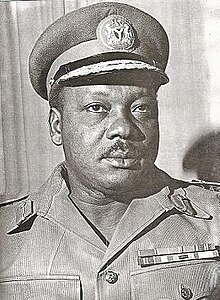Johnson Aguiyi Ironsi Military Administrations In Nigeria (17th January 1966 – 29th July 1966)

| Thomas Umunnakwe | Aguiyi-Ironsi |
|---|---|
| Full Name | Johnson Thomas Umunnakwe Aguiyi-Ironsi |
| Date of Birth | 3rd March, 1924 (Birth) – 29 July, 1966 (Died) 42 Years |
| Nationality | Nigeria |
| Place of Birth | Lalupon, Oyo Nigeria |
| Political Party | NIL (Military) |
| Service | Nigerian Army |
| In Office | 17th January 1966 – 29th July 1966 (Head of State) 1942 – January 1966 (Major General – Army) |
J.T.U. Aguiyi Ironsi Military Government In Nigeria
J.T.U. Aguiyi Ironsi Military Rule (January, 1966 – July, 1966)
The deep division in the political class and the military institution itself, encouraged a few young army officers to overthrow the civilian government of Alhaji Tafawa Balewa at the dawn of 15th January, 1966.
The five military officers who initially planned and executed the coup were Major Chukwuma Kaduna Nzeogwu (Chief Instructor, Nigerian Military Training College, Kaduna), Major Wole Ademoyega, Major Christian Anuforo, Major Emmanuel Ifeajuna and Major Donatus Okafor.
While the coup initially enjoyed some measure of success in Northern Nigeria, it was badly executed in Southern Nigeria. This gave Major General Johnson Thomas Umunnakwe Aguiyi Ironsi, the General Officer Commanding (GOC) of the Nigerian Army, the opportunity to mobilize loyal troops to quell the coup by Major Nzeogwu and his collaborators.
After successfully quelling the uprising in the south, General Ironsi took over in Lagos and, soon after, what was left of the civilian government quickly transferred full responsibility for the government of Nigeria to Ironsi.
By 18th January, 1966 – Nzeogwu and the other coup plotters had been rounded up and detained in Lagos.
The January 1966 military coup resulted in the death of several top-ranking politicians and military officers. The casualties included Alhaji Abubakar (the Prime Minister), Chief Festus Okotie-Eboh (Federal Minister of Finance), Alhaji Ahmadu Bello (the Premier of Northern Nigeria), Chief S.L. Akintola (Premier, Western Nigeria), Brigadier Samuel Ademulegun (Commander of the First Brigade, Kaduna), Brigadier Zakar Maimalari (Commander, Second Brigade), Colonel Largema (Commanding Officer, Fourth Battalion), Lt Colonel Yakubu Pam (Adjutant General, Army Headquarters) and Lt. Colonel Unegbe (Quarter Master General).
As expected, the new military government suspended the constitution and banned political parties and political activities. In other words, all institutions of civil rule were outlawed.
As Head of State, J.T.U. Aguiyi-Ironsi was also the Commander-in Chief of the Armed Forces. Each region also had a military governor. Colonel Hassan Katsina was governor of Northern Region, Colonel Odumegwu Ojukwu, Eastern Region, Lt. Colonel Adekunle Fajuyi, Western Region and Lt. Colonel David Ejoor for Mid-Western Region.
In this new dispensation, both legislative and executive powers were vested in the military government at federal and regional levels. The Supreme Military Council (SMC) was the highest decision-making organ of government and the National Executive Council was the executive arm of government.
The Head of State was the chairman of both bodies.
At the state level, the military governor was the State’s chief executive. He also served as the chairman of the State Executive Council, which was the executive arm of the government. The governor made edicts which had the force of law just as decrees were made by the central government.
The constitutional changes did not, however, affect the judiciary which continued to function as stipulated under the 1963 Republican Constitution.
The greatest undoing of the Ironsi regime was its decision to convert Nigeria into a unitary state through the Unification Decree of 29th May, 1966. This led to riots and disturbances in parts of Northern Nigeria and the killing of many southern Nigerians resident in the north. These crises heralded the coup of July 1966 – the second Military coup in Nigeria.
